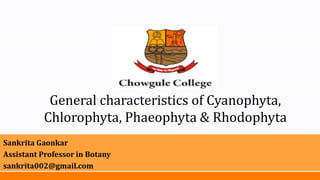
General characteristics of algae
- 1. General characteristics of Cyanophyta, Chlorophyta, Phaeophyta & Rhodophyta Sankrita Gaonkar Assistant Professor in Botany sankrita002@gmail.com
- 2. Contents • Cyanophyta • Chlorophyta • Phaeophyta • Rhodophyta • references
- 3. Cyanophyta Division: Cyanophyta=Cyanophycophyta Class: Cyanophyceae 1. Order: Chroococcales – Chroococcus, Synechocystis, Microcystis, Synechococcus, Gloeothece 2. Order: Oscillatoriales – Oscillatoria, Lyngbya, Spirulina 3. Order: Nostocales – Nostoc, Anabaena, Aulosira
- 4. General characteristics: • Small primitive group – 2,500 species – 150 genera • Only known oxygen producing prokaryotes • Simplest living autotrophs • Cellular organization – prokaryotic • Absence of well defined nucleus • Absence of cell organelles • Flagella absent
- 5. • Thallus organization 1. Unicellular forms – spherical or oval (Chroococcus, Synechococcus) 2. Colonial forms o Non-filamentous – Coelosphaerum, Gomphophaera, Microcystis o Filamentous (trichome) – branched (Westiella, Hapalisiphon), unbranched (Oscillatoria, Lyngbya) • Flagella – absent • Movement – gliding motion, jerky type • Photosynthetic pigments – Chlorophyll a, β-carotene, unique – Phycobilins (phycocyanin and phycoerythrin), xanthophylls (myxoxanthin and mycoxanthophyll)
- 6. • No membrane bound chromatophores • Storage products – myxophycean starch, proteinaceous material- cyanophycin • Filamentous blue-greens – heterocysts • Nutrition – photoautotrophs
- 7. • Sexual reproduction – absent • Asexual reproduction • i) vegetative methods – fission (septum formation), fragmentation, hormogones formation • ii) spore formation – akinetes, endospores, exospores, nannocytes Fission Fragmentation
- 8. Chlorophyta Division: Chlorophyta = Chlorophycophyta Class: Chlorophyceae 1. Order: Volvocales: Pyramimonas, Chlamydomonas, Gonium,Volvox 2. Order: Tetrasporales: Tetraspora 3. Order: Chlorococcales: Chlorococcum, Pediastrum, Hydrodictyon 4. Order: Chlorellales: Chlorella, Ankistrodesmus, Oocystis, Scenedesmus 5. Order: Ulotrichales: Ulothrix, Microspora 6. Order: Cladophorales: Cladophora 7. Order: Zygnematales: Spirogyra, Closterium, Zygnema
- 9. General characteristics: • Large number of species – 20,000 • Eukaryotic – membrane bound nucleus and organelles • Thallus – green – chlorophyll – chloroplast • Thallus organization 1. Unicellular – motile (Chlamydomonas), non-motile (Chlorella) 2. Colonial – motile (Volvox), non-motile (Hydrodictyon) 3. Coenocytic or siphonaceous – Acetabularia 4. Multicellular filamentous – Spirogyra
- 10. • Cell wall – inner layer – cellulose, outer layer – pectose • Siphonales – callose • Photosynthetic pigments – Chlorophyll a, b, carotene, xanthophyll • Chloroplast shapes – cup-shaped, reticulate, collar, discoid, axile plate, ribbon, stellate, band-like Cup-shaped Reticulate Collar Ribbon-shaped Stellate
- 11. • Pyrenoids – proteinaceous bodies embedded in chloroplast – storage product • Eye-spot or stigma – associated with chloroplast – photoreceptive • Flagella – whiplash
- 12. • Reproduction 1. Vegetative – cell division (fission), fragmentation, akinetes 2. Asexual – asexual spores – zoospores (motile, bi- or quadri-flagellate), aplanospores (non-motile autospores) – thick-wall formation (hypnospores) 3. Sexual – homothallic (monoecious), heterothallic (dioecious) i) Isogamy – gametes are alike – size, structure, behaviour ii) Anisogamy – dissimilar gametes iii) Oogamy – distinct sex organs – antheridium (male), oogonium (female)
- 13. Phaeophyta Division: Phaeophyta = Phaeophycophyta (brown algae) Class: Phaeophyceae 1. Order: Ectocarpales – Ectocarpus 2. Order: Dictyotales – Dictyota 3. Order: Laminariales – Laminaria 4. Order: Fucales – Fucus, Sargassum
- 14. General characteristics: • 1500-2000 species are known. most complex forms of algae • Mostly found in deep seas and oceans, only a few phaeophyta are freshwater species. Commonly adapted to marine environment • Range from a microscopic length to several meters. giant kelp can reach to about 70 meters in length • autotrophic, multicellular organisms • Pigments: xanthophyll (fucoxanthin, lutein, flavoxanthin, violaxanthin), chlorophyll a, c, carotene Kelp
- 15. • Thallus organization • All are multicellular and sessile • General construction – holdfast, stipe, blade • have air bladders, meant for floating photosynthetic parts on or near the water surface for harvesting light. • Cell wall – inner cellulosic, outer gelatinous and pectic (algin or fucoidin) • Food reserve – sugars Giant kelp Sargassum
- 16. • Reproduction • Asexual – vegetative (fragmentation, propagula) and spore formation (zoospores) • Sexual – Isogamy, anisogamy, oogamy Propagule
- 17. Fucus
- 18. Rhodophyta Division: Rhodophyta = Rhodophycophyta (red algae) Class: Rhodophyceae 1. Order: Bangiales - Porphyra 2. Order: Nemalionales - Batrachospermum 3. Order: Ceramiales - Polysiphonia
- 19. General characteristics: • Sea weeds – marine • Fresh water forms – 200 species • Thallus – non-motile, unicellular (Porphyridium), most are multicellular, filamentous (Goniotrichum), ribbon-like (Porphyra) 1. Uniaxial – one axial filament 2. Multiaxial - tuft of axial filament Uniaxial Multiaxial Porphyridium Porphyra
- 20. • Cell wall – outer mucilaginous, slimy, contains sulphated galactans (agar- agar, porphyran, furcellaran) and inner cellulosic - polysulphate esters • Cell wall – pits – protoplasmic continuity – phylogenetic significance • Pyrenoids – reserve proteins • Absence of flagella • Photosynthetic pigments – chlorophyll ‘d’, carotenoid – taraxanthin, bilioproteins- R-phycocyanin, R-phycoerythrin • Food storage products – floridean starch, galactoside floridoside • Sexual reproduction – oogamous – spermatangium (spermatia), carpogonium (egg) • Source of Agar-- Gracilaria
- 21. References • Vashishta B.R., Sinha A.K. and Singh V.P. 2012. Botany for degree students: Algae. S. Chand & company ltd. • Fritsch, F.E.,(1956). The structure and reproduction of the Algae; Volume I and II. Cambridge University Press.